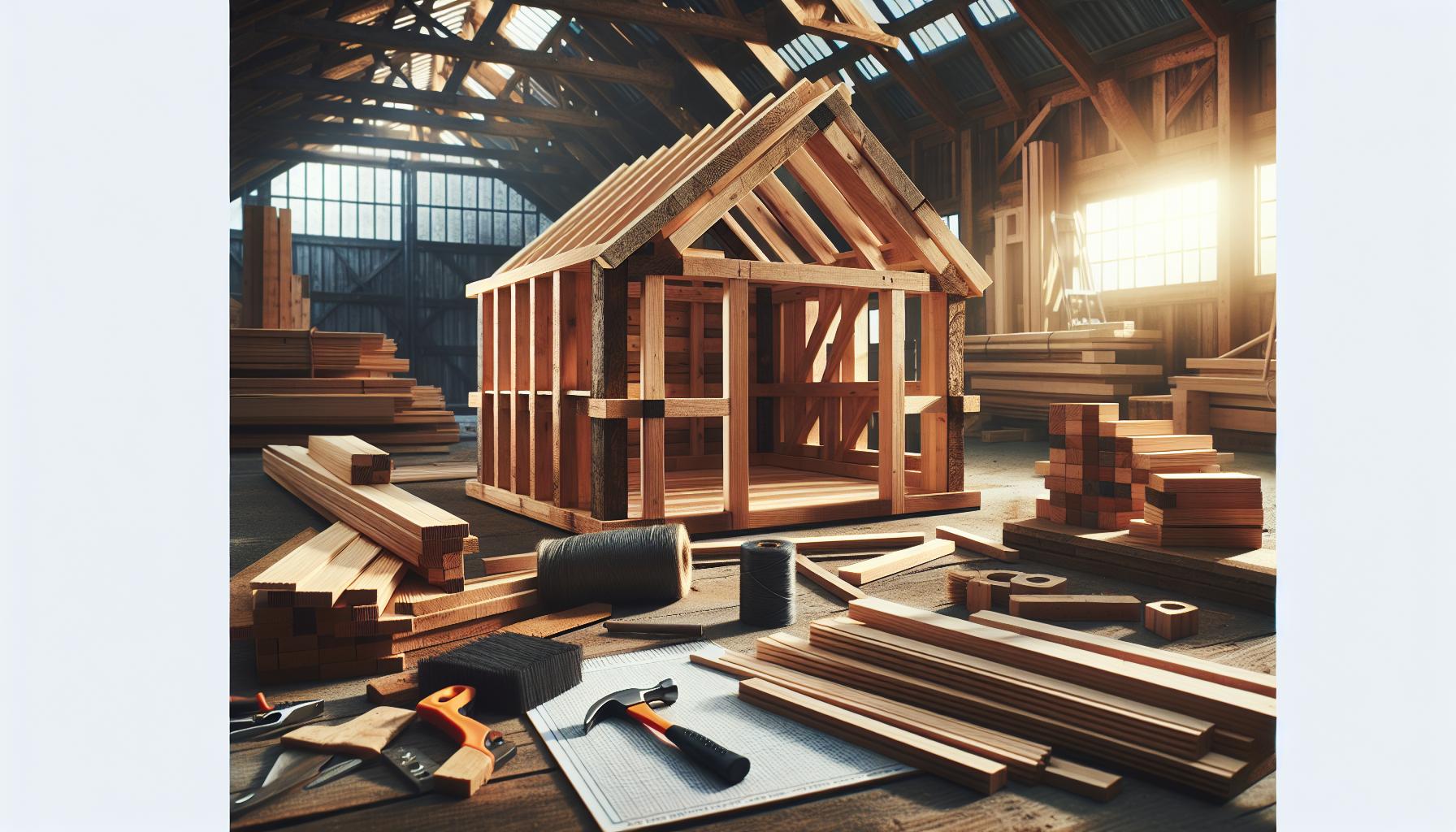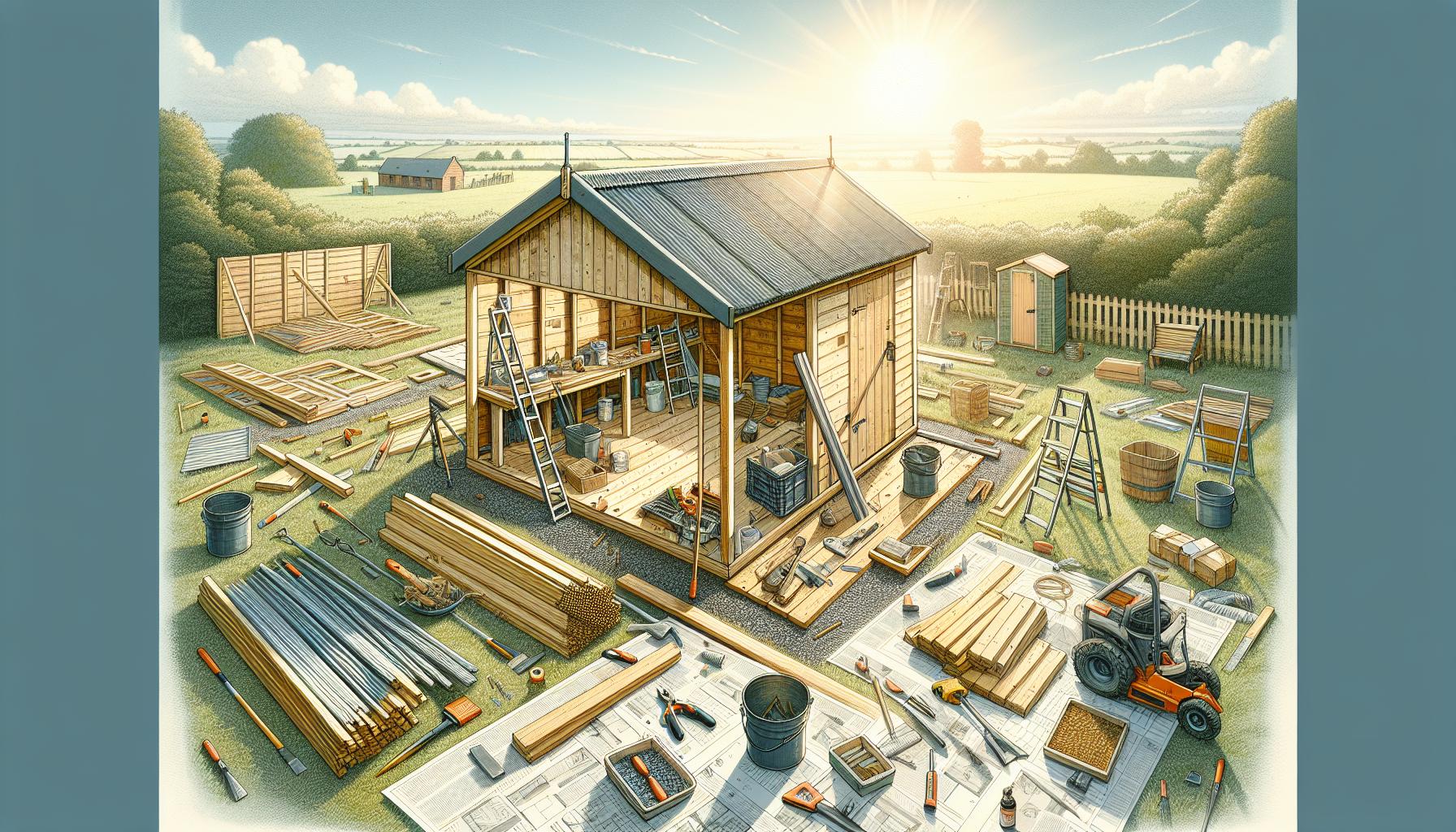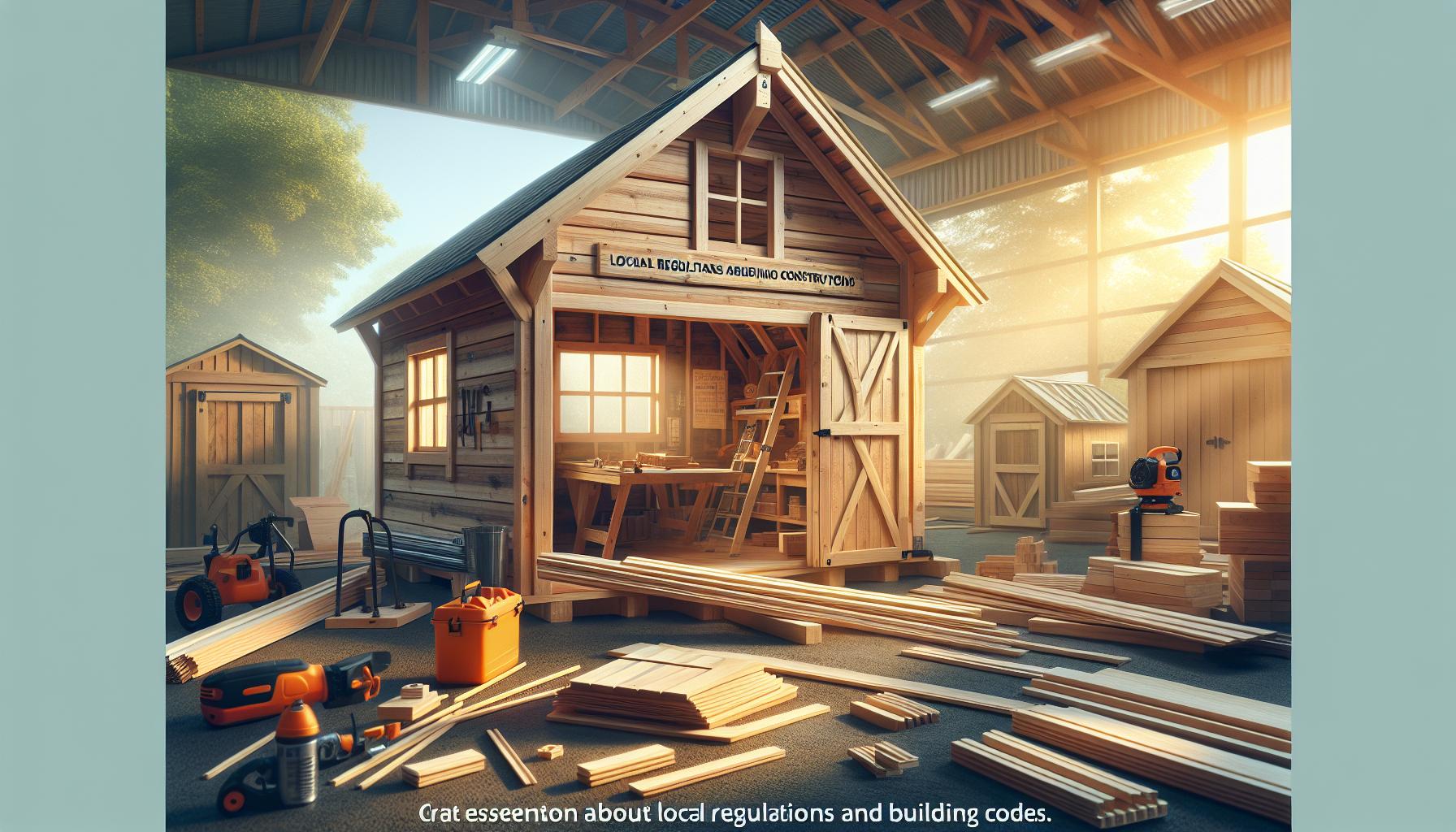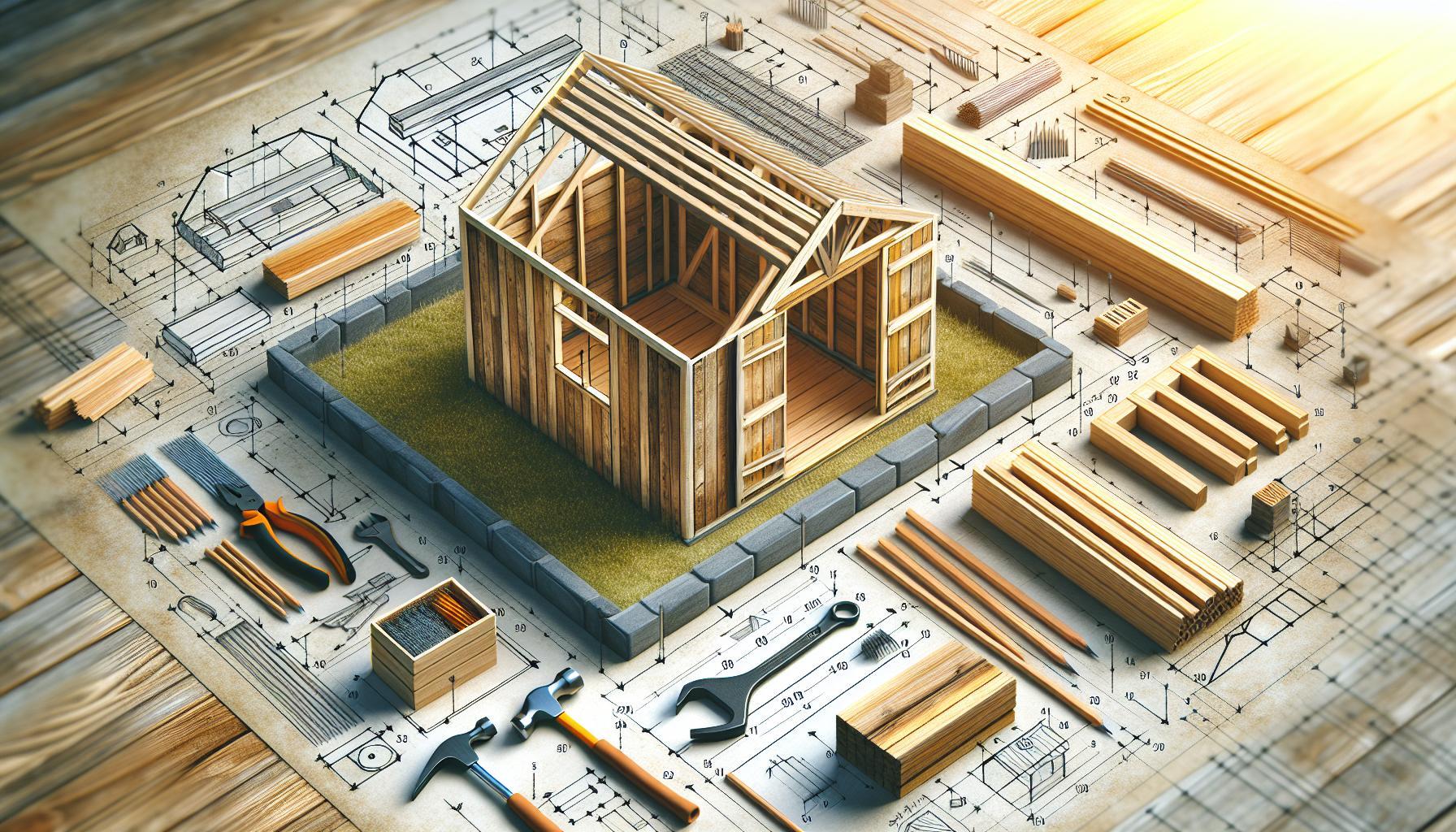A strong foundation is crucial for the longevity and stability of any shed. Neglecting this vital step can lead to structural issues over time, compromising both functionality and aesthetic appeal. This guide will walk you through essential techniques and materials to ensure your shed remains secure and functional for decades, making your investment worthwhile.
Understanding the Importance of a Solid Shed Foundation
A sturdy foundation is the backbone of any shed, influencing it’s longevity and structural integrity. Without it, your investment may succumb to the elements, leading to costly repairs or complete replacement. A solid foundation not only provides a level surface for your shed but also elevates it above ground moisture, minimizing rot and deterioration. In regions prone to heavy rainfall or erosion, a well-constructed foundation becomes even more critical in safeguarding your shed from environmental damage.
Choosing the right foundation type is essential for maximizing durability. Several options exist, each with unique advantages depending on your specific needs and budget. Here are a few popular choices:
- Concrete Slabs: These are highly durable and offer excellent weight distribution.They are ideal for larger sheds and regions with wet climates.
- Concrete Piers: Another popular option, these are simpler to install and accommodate for uneven ground. They elevate the shed, providing better drainage.
- Gravel Foundations: Cost-effective and relatively easy to build, gravel helps with drainage and is suitable for smaller structures.
Each foundation type plays a significant role in ensuring stability and extending the lifespan of your shed.For instance, using concrete piers can simplify installation while effectively addressing ground slope issues, whereas a concrete slab offers unmatched stability suitable for heavy equipment storage. Evaluating your location, expected load, and budget will guide your choice, emphasizing the importance of selecting an appropriate foundation for achieving not only short-term functionality but also long-term performance.
When constructing your shed foundation, meticulous planning and execution are vital. Start by assessing the site; ensure it is level and adequately drained. Investing time in properly marking your foundation layout will lead to a much smoother construction process.Experienced builders recommend following a step-by-step guide, such as those found in complete articles on how to build a shed foundation, to secure your structure for decades to come. Remember, a solid foundation isn’t just the start of a project; it’s an investment in the durability and usability of your shed for years ahead.
Choosing the Right Foundation Type for Your Shed
Choosing the proper foundation for your shed is crucial for ensuring its stability and longevity. Many shed owners overlook this fundamental step, unaware that the right foundation can prevent issues like rot, settling, and door misalignment. A well-constructed foundation supports not only the weight of the shed but also protects it from moisture infiltration and damage due to soil movement. With several foundation types available, it’s essential to consider the specific needs of your shed and local environmental conditions.
Common foundation Types
There are various foundation types suited for different soil conditions and shed designs.Here are some of the most common options:
- Concrete Slab: A solid concrete base provides excellent stability and moisture resistance. Ideal for sheds that will house heavy equipment or valuable tools, a concrete slab can also handle significant weight without shifting.
- Concrete Blocks: This foundation type is adaptable and fairly easy to install.Concrete blocks allow for ventilation and are less susceptible to moisture damage than wood.
- Gravel Pad: A gravel foundation involves creating a leveled area filled with gravel to promote drainage and stabilize the shed. It works well in areas where water drainage is a concern.
- Skids: Using pressure-treated wood skids can elevate the shed off the ground, preventing rot and decay. This option is suitable for smaller structures or temporary sheds.
Factors to Consider
When deciding on the right foundation, consider these key factors:
- Soil Type: Assess the type of soil in your area. Clayey soils retain moisture, while sandy soils drain quickly. this will influence your foundation choice.
- Local Weather: If you live in an area with heavy rainfall, a concrete slab or gravel pad is advisable to ensure water drainage and prevent flooding.
- Shed size and Weight: Larger and heavier sheds typically require more ample foundations like concrete slabs, while smaller sheds might be supported adequately by skids or blocks.
Choosing the correct foundation type is a vital step in your journey to build a shed that will stand strong for years to come.By considering the unique needs of your shed and the conditions of your property, you can create a solid base that protects your investment effectively. As the saying goes, “A good foundation supports everything that follows.”
Essential Tools and Materials for Building Your Foundation
When embarking on the journey of constructing a solid shed foundation, having the right tools and materials at your disposal is crucial.The success of your project hinges not just on your knowledge of how to build a shed foundation but also on selecting the best components that will secure your structure for decades to come. Quality materials play a significant role in ensuring stability,while the right tools will help streamline your building process,saving you time and effort.
Essential Tools
Equipping yourself with the appropriate tools can make a significant difference in both the efficiency and effectiveness of your foundation build. Here’s a list of indispensable tools that you’ll need:
- Measuring Tape: Precision is key, so a sturdy tape measure will help you lay everything out correctly.
- Level: Ensuring that your foundation is even will prevent issues down the line.
- Shovel: Essential for digging out the site, especially for gravel or concrete foundations.
- Post-hole Digger: If you are working with concrete piers or posts, this specific tool will aid in digging the correct holes.
- Hammer & Nails/Or a Nail Gun: Depending on your foundation choice, you may need these for securing wooden elements.
- Saw: A circular saw is ideal for cutting lumber to size for framing your foundation.
- Concrete Mixer: If pouring a concrete slab, having a mixer can save significant effort and time.
Materials for Your Foundation
Choosing the right materials is just as vital as having the right tools.Depending on the type of shed foundation you decide to build—be it gravel, concrete, or wood—here are the essential materials you will likely need:
| Foundation Type | Materials Needed |
|---|---|
| Gravel | Gravel, Landscape Fabric |
| concrete Slab | Concrete Mix, Rebar, Gravel (for base), Form Boards |
| Wooden Skids | Pressure-treated Lumber, Deck Screws or Nails |
For gravel foundations, using landscape fabric underneath can prevent weed growth while allowing for drainage. Meanwhile, concrete foundations require careful planning with form boards to shape the concrete. It’s also crucial to embed rebar within the mixture for added durability.Lastly, if choosing wooden skids for your shed, ensure that you’re using pressure-treated lumber to withstand moisture and pests.Investing in high-quality materials is a decision that pays off in the long run, ensuring your shed remains sturdy through weather extremes and the wear of time.With the right tools and materials in hand, you are already on the right path to creating a foundation that supports your structure solidly for many years to come.
Step-by-Step Guide to laying a concrete Foundation
When it comes to constructing a shed,the foundation is one of the most critical elements to ensure its longevity and structural integrity. A solid concrete foundation not only provides stability but also protects your shed from moisture and pests, ensuring it remains a valuable storage space for years to come. Follow this comprehensive guide to effectively lay a concrete foundation that will secure your structure for decades to come.
Gathering Your Materials
Before beginning this project, it’s essential to assemble all necessary materials and tools. Here’s a checklist to help you get started:
- Concrete mix (ready-mix or premixed, depending on your preference)
- Gravel for drainage
- Concrete forms (wood or plastic)
- Reinforcing mesh or rebar
- Leveling tool (like a laser level)
- Shovel and rake
- Mixing tools (wheelbarrow, hoe, or mixer)
- Concrete finishing tools (trowel, float)
- Safety gear (gloves, goggles)
Preparing the Site
Once your materials are ready, it’s time to prepare the site. Start by selecting a proper location that is level and free from obstructions. Follow these steps to ensure a solid base:
- Mark the Area: Use stakes and string to outline the dimensions of your foundation.
- Excavate the Ground: Remove the topsoil and any grass within the marked area to a depth of about 4-6 inches to accommodate the gravel and concrete.
- Create a Gravel Base: Add a layer of gravel (approximately 2-3 inches deep) to promote drainage and compact it well.
Laying the Concrete Forms
The next step involves constructing the concrete forms. These wooden frames will contain the wet concrete during the pouring process:
- build the Forms: Cut the wood into appropriate lengths based on your shed’s footprint and assemble them into a rectangular shape, securely nailing or screwing the corners.
- Level the Forms: Use your leveling tool to ensure the forms are perfectly flat and even, adjusting the height with shims or additional gravel as needed.
- Secure with Stakes: Drive stakes into the ground outside the forms to hold them in place during the pouring of the concrete.
Pouring and Finishing the Concrete
With your forms in place, you’re ready to pour the concrete. Follow these steps to ensure a successful pour:
- Mix the Concrete: Following the manufacturer’s instructions, mix the concrete to achieve a thick, pourable consistency. You can use a mixer or mix it by hand for smaller batches.
- Pour the Concrete: Start pouring the concrete into the forms,ensuring all corners fill completely. Use a shovel to push the mix into the edges if necessary.
- Level and Smooth: Once the forms are filled, use a trowel to level the surface. A float can help smooth any rough patches for an even finish.
Curing and setting
Allow the concrete to cure properly for maximum strength:
- Cover the foundation with plastic sheeting to retain moisture.
- Let it set for at least 24-48 hours before removing the forms.
- Continue to keep the surface moist for about a week for optimal curing.
Following these steps will allow you to create a stable and durable concrete foundation for your shed, ensuring it stands the test of time. A robust foundation not only enhances the overall construction experience but also secures your structure against the elements for decades to come.
Preparing the Site: Clearing and leveling for Success
Preparing a solid base for your shed begins long before the first board is laid. The success of your structure heavily relies on the preparation of the site, specifically the clearing and leveling process. Proper site preparation not only enhances the longevity of the shed by preventing issues such as water pooling and shifting but also ensures that your shed remains aesthetically pleasing and functional.
Before diving into the actual leveling, take the time to clear the area where your shed will reside. This involves removing any grass, weeds, or debris that may interfere with your foundation. Here’s how to effectively clear your site:
- Inspect the Area: Identify any large rocks, tree roots, or remnants of old buildings that will need to be removed.
- Use Appropriate Tools: Equip yourself with a shovel, rake, and possibly a pickaxe for stubborn roots. A sod cutter can make speedy work of grass and soil layers.
- Consider Drainage: Ensure that your site has adequate drainage by observing water flow patterns during rain, which can influence the shed’s placement.
Once the site is cleared, the next step is leveling the ground. A well-leveled site is crucial for a strong foundation and can be achieved using these simple methods:
Methods for Leveling Your shed Site
- String Leveling method: Stretch a string line between stakes at either end of the area, adjusting the height until it’s level. Use a carpenter’s level to check each section.
- Use a Laser Level: For more precision, especially on larger sites, a laser level can provide an accurate measurement across the area.
- Fill Low Spots: Use soil or gravel to fill low areas and create a smooth, even surface. Compact the fill material to prevent settling.
Remember, the final goal of this preparation phase is to establish a reliable foundation for your structure, which will promote structural integrity and safeguard against common issues like sagging or water damage. As you engage in the process of understanding how to build a shed foundation effectively, prioritizing site preparation is an investment in the durability and success of your construction project. A well-prepared site will contribute significantly to a secure structure for decades to come.
Common Mistakes to avoid When Building a Shed Foundation
Many aspiring shed builders overlook the critical importance of a solid foundation,often leading to costly mistakes down the road. Neglecting proper planning or using subpar materials can jeopardize the longevity of your shed, causing it to shift, warp, or even collapse over time. Understanding and avoiding common pitfalls when constructing a foundation is essential to ensure your structure remains sturdy and functional for decades to come.
Insufficient Site Preparation
One of the most frequent errors is failing to properly prepare the site before laying down a foundation.A level, well-drained area is crucial; without it, you risk water pooling around your shed, leading to rot and decay. clear away debris, vegetation, and any topsoil to reveal firm ground. Consider the following steps for effective site preparation:
- Mark the outline of your shed with stakes and string to visualize the space needed.
- Excavate the area to a depth sufficient to accommodate your chosen foundation, ensuring the ground is flat.
- Install a drainage system if your area is prone to heavy rainfall,directing water away from your shed.
Choosing the Wrong Materials
Ignoring material quality can spell disaster for your shed foundation. Using untreated wood or low-quality concrete is a common mistake that leads to premature deterioration. rather, opt for durable materials such as:
| Material | Benefits | Recommended Uses |
|---|---|---|
| Pressure-treated lumber | Resistant to rot, insects, and decay | Skids, framing, and support beams |
| Concrete blocks | Strong and durable | Post bases and foundation supports |
| Gravel | Excellent drainage properties | base layer for crushed stone foundations |
By investing in high-quality materials that can withstand the elements, you’ll create a solid foundation that serves your shed well over the years.
Neglecting to Check Local Regulations
A common oversight is failing to familiarize yourself with local building codes and regulations. Many areas have specific requirements for shed foundations, including height restrictions, permits, and foundation types. Ignoring these regulations can lead to fines or the need to dismantle and rebuild your shed. Always research:
- Your local zoning laws regarding shed sizes and placement.
- Any necessary permits required before construction.
- Recommendations for foundations based on local soil types and weather conditions.
Building a shed foundation without adhering to local regulations may not only affect your structure’s integrity but also cause long-term headaches. by avoiding these mistakes and understanding the essential elements of how to build a shed foundation effectively, you can secure your structure for decades to come.
Local Regulations and Building codes: What You Need to Know
When embarking on your shed-building journey, it’s vital to recognize that your plans will likely be affected by local regulations and building codes. Ignoring these constraints can lead to hefty fines, forced demolitions, or even delays in your project. Each jurisdiction has its own set of rules governing construction, and understanding these can make the difference between a smooth build and a challenging experience.
Why Local Regulations Matter
Navigating the maze of local regulations helps ensure the longevity and safety of your shed. Building codes are established partly to protect the public, and they encompass everything from structural integrity to fire safety. For instance, certain areas may have specific requirements regarding the distance your shed must be from property lines, while others may dictate the type of materials you can use for your foundation. Familiarizing yourself with these guidelines is a crucial step in how to build a shed foundation that’ll secure your structure for decades to come.
Key Regulations to Consider
Before laying the first stone of your foundation, consult your local building department to acquire the necessary permits and understand key regulations. Here are some aspects to consider:
- Building Permits: Most municipalities require a permit for any permanent structures. Check if your shed falls under this category.
- Zoning Regulations: Your property may have restrictions based on zoning laws.This could affect the size, height, and location of your shed.
- Foundation Specifications: Some regions may mandate specific types of foundations, such as concrete slabs, piers, or skids, depending on the soil type and frost line.
- Setback Requirements: Determine how far your shed must be from property lines or other structures on your property to avoid conflicts.
Resources for Compliance
to effectively navigate the regulatory landscape, consider the following resources:
| Resource Type | Description |
|---|---|
| Local Building Department | Your primary point of contact for regulations and permits. |
| Online building Code Databases | Many states have websites where you can search for building codes applicable to your area. |
| Home Improvement Forums | Engage with fellow builders who may have faced similar regulatory hurdles. |
| Professional contractors | Hiring a local contractor familiar with regulations can save time and ensure compliance. |
Staying informed and compliant with local regulations will not only safeguard your investment but also enhance the durability and safety of your shed. Whether you’re planning to build a simple storage shed or a more elaborate garden sanctuary, understanding these codes is an essential piece of the puzzle in how to build a shed foundation that stands the test of time.
Maintenance Tips to ensure Your Foundation Stands the Test of Time
When it comes to home improvement projects, the foundation is the unsung hero that underpins the integrity of your structure. Much like a building, a shed requires a solid footing to endure the test of time. Neglecting the maintenance of your shed foundation can lead to catastrophic damage, undermining the very purpose of your structure. To secure your shed’s foundation and ensure it stands firm for decades to come,adhering to a few maintenance tips is crucial.
Regular Inspections
Conducting regular inspections allows you to catch potential issues before they escalate into costly repairs. Look for signs of:
- cracks or gaps in the concrete or wood.
- Moisture accumulation around the foundation area.
- Shifts in the structure, such as doors not closing properly.
- Insect infestations, which can compromise the integrity of wooden foundations.
Make it a habit to check for these issues at least twice a year, ideally in spring and fall when weather conditions are most stable.
Maintain Proper Drainage
One of the most critical aspects of foundation longevity is effective drainage. Poor drainage can lead to water pooling around the base, which can erode the foundation over time. Here’s how to maintain proper drainage:
- Ensure that gutters and downspouts are clear and direct water away from the foundation.
- Install a French drain if your shed is in a low-lying area prone to flooding.
- Grade the surrounding soil so that it slopes away from the shed to promote runoff.
By managing water flow effectively, you reduce the risk of moisture-related damage and mold growth.
Protection Against Pests
Another vital maintenance tip involves protecting your shed’s foundation from pests. Termites and rodents can be particularly damaging, so consider the following preventive measures:
- apply a pesticide barrier around the perimeter of the foundation.
- Store firewood and other materials at least twenty feet away from the shed.
- Seal any cracks where pests could enter.
Regularly check for signs of pest activity, and don’t hesitate to call in professionals if an infestation is detected.
Table: Foundation Maintenance checklist
| Task | Frequency | Notes |
|---|---|---|
| Inspect for cracks or shifts | Twice annually | Spring and fall are ideal. |
| Check drainage systems | Before rainy seasons | Clear debris from gutters and downspouts. |
| Apply pest control | Annually | Consider professional services if needed. |
| Assess landscaping around the shed | As needed | Avoid vegetation that retains too much moisture near the foundation. |
By keeping up with these essential maintenance tips, you can ensure that your shed foundation remains robust and reliable. Just as understanding how to build a shed foundation is crucial for its initial stability, ongoing care is key to maintaining that strength for years to come.
Frequently asked questions
How to Build a Shed Foundation: Secure Your Structure for Decades to come?
To build a shed foundation that lasts, start by determining the appropriate type: concrete slab, gravel pad, or post foundation. Each method offers unique benefits, depending on your shed size and local conditions.
A strong foundation is vital for your shed’s longevity. A concrete slab provides a solid base, while a gravel pad allows for drainage, making it ideal in wet areas. Research local building codes to ensure compliance and best practices.
What is the best type of foundation for a shed?
The best type of foundation for a shed often depends on your location and the shed design. Common options include concrete slabs, gravel pads, and skids.
Concrete slabs are resilient and great for permanent structures. Gravel pads provide excellent drainage and are easier to install. If you expect frost heave, consider post foundations that elevate the shed above the ground.
Why does a shed need a proper foundation?
A proper foundation is crucial for your shed because it prevents settling, protects against moisture, and provides stability. Without a solid base, your structure may suffer from uneven weight distribution and potential damage.
Investing in a strong foundation enhances your shed’s integrity and extends its lifespan by reducing the risk of water damage and rot. Properly built foundations ensure your shed remains functional and secure over the years.
Can I build a shed foundation myself?
Yes, you can build a shed foundation yourself, especially if you follow clear instructions and have basic construction skills. Many DIY enthusiasts successfully tackle this project with the right tools and materials.
Start by researching detailed guides on how to build a shed foundation and gather necessary supplies. Online resources offer step-by-step directions,making the job manageable even for beginners. Don’t hesitate to ask for help if needed!
What materials do I need to build a shed foundation?
To build a shed foundation, you will need materials like concrete, gravel, wood beams, or treated lumber, depending on the type of foundation you’re constructing. Choose materials suited to your local climate.
for a concrete slab, gather forms, rebar, and concrete mix. For a gravel pad, you’ll need landscaping fabric and various gravel sizes. Understanding your shed’s requirements ensures you select the right materials for stability and durability.
How deep should a shed foundation be?
The depth of a shed foundation varies by type; typically, for a concrete slab, a depth of 4-6 inches is advisable, while post foundations should extend below the frost line, which may be 12-30 inches in some areas.
Shallow foundations work for lightweight sheds, but deeper bases prevent frost heave in colder climates. Always check local building codes to ensure compliance with regional requirements.
Can I use pavers for a shed foundation?
Yes, you can use pavers for a shed foundation, especially for smaller sheds or in areas with minimal frost heave.Pavers can create a level base while allowing for *drainage.*
Just ensure the ground is well-prepared; you may need to dig and compact the soil before laying pavers. While this option is viable, it’s best suited for sheds that are not too heavy or large.
Insights and Conclusions
building a strong foundation for your shed is not only essential for the longevity of your structure but also serves as a rewarding project that can enhance your skills and confidence as a builder. We’ve explored the critical steps—from selecting the appropriate site to understanding different types of foundations, such as concrete, gravel, and timber. Remember, a solid foundation is the bedrock of a safe and durable shed.
As you embark on your building journey, keep in mind the importance of local building codes and regulations to ensure compliance and safety. While the process may initially seem daunting, breaking it down into manageable steps can make it an enjoyable and fulfilling experience.
Whether you’re a novice eager to learn or a seasoned builder honing your craft, the satisfaction of watching your vision come to life is unparalleled. We encourage you to dive deeper into the resources available, seek out tutorials, and engage with fellow builders. Your shed foundation is just the beginning—let your creativity flourish as you explore the limitless possibilities of building and design!








